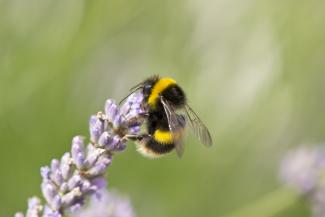
Image Credit: Benjamin Watson
Bumblebees: (Apidae: tribe Bombini: Bombus)
There are nearly 50 species of bumblebees in North America, with about 2 dozen in the PNW. Bumblebees need no special introduction here. There are several species included in the subgenus Psithyrus (often treated as the genus Psithyrus), of cuckoo bumblebees. Some of these cuckoos are obligate kleptoparasitic nest-parasites while others are typical social bees under arctic conditions of plenty – but parasitic under conditions when or where nest sites are apparently severely limited.
Bumblebees, like the sweat-bees, live according to a different annual clock. All other solitary bees spend the winter season as a pupa or pre-pupa, but bumblebees and sweat-bees produce their nascent sexual individuals at the end of the summer. The sexuals mate and the mated females overwinter.
Bombus vosnesenskii usually produces very large colonies (of many dozens to several hundred workers), which may even overwinter. Other bumblebees, typically the arctic/alpine species, produce only small colonies of a few dozen workers, which often do not last until the end of summer.
Bombus occidentalis, the “western” or “white-tailed bumblebee”, has undergone drastic population crashes throughout the western USA. In Oregon, it was the most abundant species along the immediate coast (and one of the top 4 at high altitudes). It was the most important pollinator along the coast of the largest number of plant genera, but now it is at least locally extinct. Interestingly, it was the only species of bumblebee, to my knowledge, that knew how to “rob” flowers; if flowers were not of a shape the bee could enter successfully, the bee knew to go to the rear of the flower and bite through the petals to get to the nectar, without allowing any indirect pollination service.


Bombus vosnesenskii, the commonest species in the PNW (left), on the left and the now critically endangered B. occidentalis on the right.


One of the red-banded species on the left and one of the black bull’s-eye species in three photos on the right.